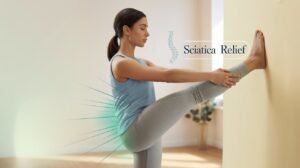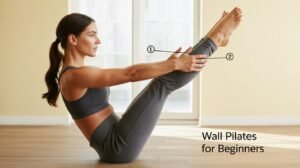Breathing is more than just an automatic bodily function; it’s a powerful tool that can significantly impact your physical performance and mental state. In the context of Wall Pilates, integrating proper breathing techniques can elevate your workout, enhance muscle engagement, and promote deep relaxation. This blog delves into how specific Wall Pilates breathing techniques can improve your performance and provide a sense of calm and relaxation.
The Importance of Breathing in Pilates
In Pilates, breath control is fundamental. It supports the body through movements, helps maintain focus, and facilitates the engagement of core muscles. Here’s why breathing is essential in Wall Pilates:
- Oxygen Supply: Efficient breathing ensures that your muscles receive the oxygen they need to function effectively, improving endurance and performance.
- Core Activation: Coordinated breathing helps activate the deep core muscles, providing stability and support for your movements.
- Mind-Body Connection: Focusing on your breath enhances your awareness of how your body moves and feels, promoting a deeper connection between mind and body.
- Relaxation and Stress Reduction: Controlled breathing can calm the nervous system, reduce stress, and promote a sense of relaxation and well-being.

Key Wall Pilates Breathing Techniques
Integrate these breathing techniques into your Wall Pilates practice to boost your performance and achieve deeper relaxation:
1. Lateral Breathing
- Description: Lateral breathing focuses on expanding the ribcage sideways and backward, allowing for deep, full breaths that support core engagement and maintain stability.
- How to Do It: Place your hands on your lower ribs. Inhale deeply through your nose, feeling your ribcage expand sideways and backward. Exhale through your mouth, gently pulling your navel towards your spine to engage your core.
- Benefits: This technique enhances lung capacity, supports core activation, and maintains stability during movements. It’s especially useful in exercises that require maintaining a strong core, like planks or leg lifts.
2. Diaphragmatic Breathing
- Description: Also known as belly breathing, diaphragmatic breathing focuses on deep breaths that fill the abdomen rather than just the chest. This technique promotes relaxation and efficient oxygen exchange.
- How to Do It: Place one hand on your chest and the other on your abdomen. Inhale deeply through your nose, allowing your abdomen to rise while keeping your chest relatively still. Exhale slowly through your mouth, feeling your abdomen fall.
- Benefits: This technique promotes relaxation, reduces stress, and enhances oxygen supply to the muscles. It’s beneficial during cooldowns or stretches.
3. Perseverance Breathing
- Description: Perseverance breathing involves taking short, quick breaths to maintain energy and focus during challenging exercises. It’s useful for maintaining stamina and control.
- How to Do It: Take quick, short inhales through your nose followed by rapid exhales through your mouth, similar to panting but controlled.
- Benefits: This technique helps manage exertion levels and maintain energy during intense or prolonged exercises, such as wall squats or extended plank holds.
4. Integrative Breathing
- Description: Integrative breathing combines deep, controlled breaths with the timing of movements. This technique helps synchronize breath and movement, enhancing flow and coordination.
- How to Do It: Inhale during the preparation phase of a movement and exhale during the exertion phase. For example, inhale while lowering into a wall squat and exhale while standing back up.
- Benefits: This technique improves coordination, enhances movement efficiency, and supports proper muscle engagement.
Incorporating Breathing Techniques into Your Wall Pilates Practice
To effectively incorporate these breathing techniques into your Wall Pilates routine, follow these steps:
- Begin with Breath Awareness: Start each session with a few minutes of focused breathing. Pay attention to how your breath feels and moves through your body, setting a mindful tone for your workout.
- Match Breath with Movement: As you perform each exercise, consciously coordinate your breath with your movements. Inhale during the preparation or easier phase, and exhale during the exertion or challenging phase.
- Practice Regularly: Consistency is key. The more you practice integrating these breathing techniques, the more natural and beneficial they will become.
- Listen to Your Body: Pay attention to how your breathing feels during exercises. If you find yourself holding your breath or feeling tense, pause and reset your breath.
- Use Breath for Recovery: Between exercises or sets, use diaphragmatic breathing to relax and recover, helping to maintain focus and energy throughout your workout.

Practical Wall Pilates Exercises with Breathing Techniques
Here are some Wall Pilates exercises where you can apply these breathing techniques:
1. Wall Roll Down with Lateral Breathing
- Target: Spine, Hamstrings, Core
- How to Do It: Stand with your back against the wall, feet hip-width apart. Slowly roll down your spine one vertebra at a time, allowing your arms to hang towards the floor. Use lateral breathing throughout the movement.
- Breathing Focus: Inhale deeply through your nose as you prepare to roll down. Exhale through your mouth as you roll down and again as you roll back up, focusing on expanding and contracting your ribcage.
2. Wall Squats with Perseverance Breathing
- Target: Quadriceps, Glutes, Core
- How to Do It: Stand with your back against the wall, feet shoulder-width apart. Slide down into a squat position, keeping your knees over your ankles. Hold the position, using perseverance breathing to maintain energy and focus.
- Breathing Focus: Take quick, short inhales and exhales to manage exertion and maintain the squat position comfortably.
3. Wall Supported Arm Circles with Integrative Breathing
- Target: Shoulders, Upper Back
- How to Do It: Stand with your back against the wall, arms extended out to the sides at shoulder height. Make small circles with your arms, first in one direction, then reverse.
- Breathing Focus: Inhale as you prepare for the movement, and exhale as you circle your arms. Maintain smooth, continuous breaths to enhance coordination and control.
Explore More with Wall Pilates Workouts
Ready to enhance your Wall Pilates practice with effective breathing techniques? Explore our website and mobile apps for a variety of Wall Pilates exercises, tutorials, and guided sessions that integrate these powerful breathing techniques.
- Discover Guided Workouts: Access a range of guided Wall Pilates workouts that emphasize breath control and mindfulness.
- Join Our Community: Connect with fellow practitioners, share your experiences, and find support and inspiration from others on their Wall Pilates journey.
- Learn from Experts: Benefit from expert tips and tutorials on how to effectively integrate breathing techniques into your Wall Pilates practice.
Conclusion
Breathing is a fundamental aspect of Wall Pilates that can significantly enhance your performance and promote relaxation. By incorporating specific breathing techniques, you can improve muscle engagement, coordination, and overall mental clarity. Embrace the power of breath in your Wall Pilates practice and experience the transformative benefits for both your body and mind. Visit Wall Pilates Workouts today to start exploring the incredible synergy between breath and movement!











